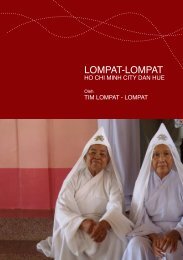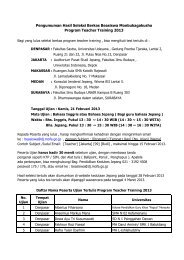9700_y16_sy
9700_y16_sy
9700_y16_sy
Create successful ePaper yourself
Turn your PDF publications into a flip-book with our unique Google optimized e-Paper software.
Cambridge International AS and A Level Biology <strong>9700</strong> <strong>sy</strong>llabus General <strong>sy</strong>llabus requirements and information<br />
At A Level only<br />
Candidates should be able to:<br />
• have sufficient understanding of probability to understand genetic ratios<br />
• understand the principles of sampling as applied to biological situations and data<br />
• understand the importance of chance when interpreting data<br />
• use the Petersen or Lincoln index to calculate an estimate of population size using mark-releaserecapture<br />
data and the formula:<br />
N = n × n 1 2<br />
m 2<br />
N = population estimate<br />
n 1<br />
= number of marked individuals released<br />
n 2<br />
= number of individuals (both marked and unmarked) captured<br />
m 2<br />
= number of marked individuals recaptured<br />
• calculate Simpson’s Index of Diversity (D) using the formula:<br />
n 2<br />
D = 1–<br />
NΣN NO<br />
O<br />
n = number of individuals of each type present in the sample (types may be species and/or higher taxa<br />
such as genera, families, etc.)<br />
N = the total number of all individuals of all types<br />
• calculate standard deviation and standard error<br />
• understand the benefits of using standard error and 95% confidence intervals (95%CI) to make<br />
statements about data and to use as error bars on graphs<br />
• understand the difference between correlation and causation; use Spearman’s rank correlation and<br />
Pearson’s linear correlation to test for correlation<br />
• use the χ 2 test and the t-test<br />
• use a spreadsheet program for analysing and presenting data, making calculations and carrying out<br />
statistical tests.<br />
5.1.1 Notes on the use of statistics in biology<br />
Candidates should know the distinction between descriptive statistics and statistical tests. They should<br />
also appreciate the requirement to choose appropriate statistical methods before planning an investigation<br />
in which they will either collect primary data or analyse secondary data. Candidates should have an<br />
understanding of the different types of variable and also the different types of data they may collect or be<br />
asked to analyse.<br />
Descriptive statistics<br />
For quantitative data, candidates should understand the difference between a normal distribution and a<br />
distribution that is non-normal. Candidates should know appropriate descriptive statistical methods to<br />
simplify their data. They should be able to use a calculator and/or spreadsheet program to find the mean,<br />
median, mode, total range, interquartile range, standard deviation, standard error and the 95% Confidence<br />
Interval (CI). Standard error (SE) and 95%CI are useful for expressing the reliability of an estimate of the<br />
mean and for putting error bars on graphs. Candidates should understand how to apply these methods<br />
and explain their significance for their own data and any given data. The 95%CI is determined as the<br />
mean ±2 × SE.<br />
Back to contents page<br />
www.cie.org.uk/alevel<br />
71





